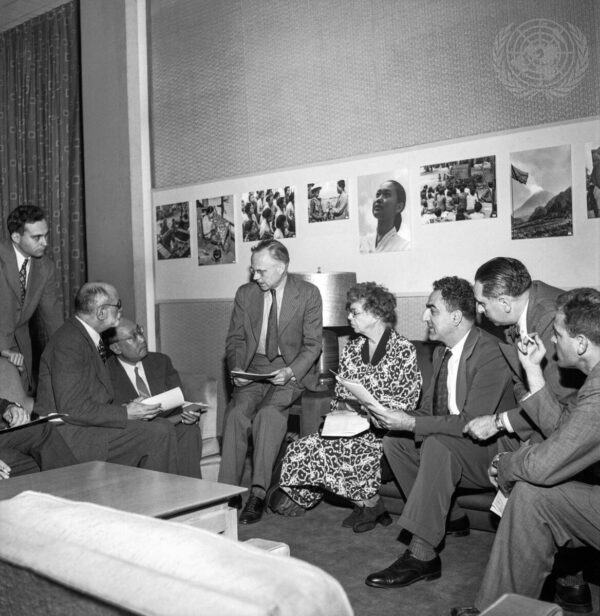
Human Rights 101: The Universal Declaration of Human Rights
In this lesson, students will learn how human rights differ from civil rights and gain introductory knowledge of how the international community united to define and defend human rights.
acf domain was triggered too early. This is usually an indicator for some code in the plugin or theme running too early. Translations should be loaded at the init action or later. Please see Debugging in WordPress for more information. (This message was added in version 6.7.0.) in /nas/content/live/ncchredu/wp-includes/functions.php on line 6121With more than 60,000,000 deaths and 25,000,000 wounded soldiers, World War II (WWII) wreaked havoc on nations and, following its conclusion, people across the world called for the international community to prevent future atrocities of such a magnitude. One of the most prominent voices supporting this call to action was President Franklin Delano Roosevelt. President Roosevelt worked tirelessly to build both international and domestic support for a peace keeping organization that would succeed where the League of Nations had failed prior to WWII.
In April of 1945, 850 delegates from 50 nations prepared to gather in San Francisco for the United Nations Conference on International Organization. The conference, later known simply as the San Francisco Conference, was set to begin on April 25th. On April 12th President Roosevelt suffered a sudden stroke and died at the “Little White House” in Warm Springs, Georgia. Despite the loss of one of its strongest supporters, the San Francisco Conference went ahead.
Over the course of two months, the conference’s delegates outlined a mission and drafted a charter. On June 25, 1945, the Charter of the United Nations was adopted unanimously and signed the following day. Following the success of the Conference, the United Nations was officially established on October 24, 1945.
The UN’s charter placed special emphasis on “fundamental human rights,” but there was a need to define exactly what this lofty term referred to. In June 1946, the Commission on Human Rights was created to compose a document that would help resolve this concern. By February 1947, the Commission had selected a handful of delegates to form the Drafting Committee to compose the initial draft of what was initially referred to as the International Declaration of Human Rights. This new committee was chaired by Eleanor Roosevelt, representing the United States, and included representatives from China, Lebanon, France, Australia, Chile, Soviet Union, United Kingdom, and Canada.
Each member of the committee played a key role. Eleanor Roosevelt established working groups to conduct research on the founding and philosophical documents of nations worldwide. Peng –Chun Chang, of China, utilized his familiarity with Western culture and his expertise on Confucian doctrine to help reach compromise between committee members. Charles Habib Malik, of Lebanon, wrote the preamble and brought a resolutely philosophical and Eastern Orthodox Christian view to the work of the committee. Though he would not yet see his call to action come to fruition, Colonel William Hodgson of Australia strongly advocated for an international court to enforce the ideals laid out in the committee’s work. Hernán Santa Cruz of Chile pushed the committee to consider human rights through a socio-economic lens in addition to a philosophical one. France’s representative, René Cassin, brought his professional expertise as a judge and his personal expertise as a former soldier and the son of a Jewish merchant to the committee deliberations. Alexander E. Bogomolov provided another Eastern perspective as the representative from the U.S.S.R. Charles Dukes (Lord Dukeston) had been an imprisoned conscientious objector during World War I, and labor union leader in England for nearly fifty years, before he was elected as one of the United Kingdom’s representatives to the UN. Finally, John Humphrey, Director of the UN Secretariat’s Division for Human Rights, was tasked with synthesizing the committee’s work into a first draft.
The first session of the Drafting Committee met from June 9, 1947 – June 25, 1947. A preliminary outline was presented to the committee with forty-eight initial articles. The Human Rights Commission then called for comment on the draft prior to the Drafting Committee’s next meeting. The Drafting Committee ‘s next session was held May 3, 1948 – May 21, 1948. During this session, the committee considered the comments they had received from governments, non-governmental organizations, other United Nations committees, and even from individuals in member states. After this second session, the Drafting Committee submitted the full draft to the Human Rights Commission. The document was approved in the third session of the Human Rights Commission and was next approved in the seventh session of the Economic & Social Council.
Finally, the International Declaration of Human Rights reached the UN’s General Assembly where it would be considered by all member nations. Over the course of 81 meetings and debate on 168 formal draft resolution proposals, the body finalised the document that was renamed the Universal Declaration of Human Rights just before its completion. On December 10, 1948, the Declaration was accepted with 29 votes in favor and seven countries abstaining from the vote. To mark this occasion, December 10 was declared Human Rights Day and became a time to reflect on our global progress towards ensuring dignity for all.
Featured in

In this lesson, students will learn how human rights differ from civil rights and gain introductory knowledge of how the international community united to define and defend human rights.